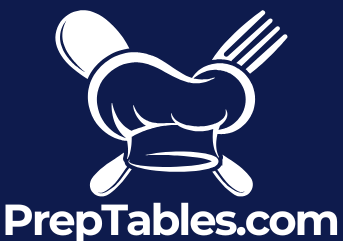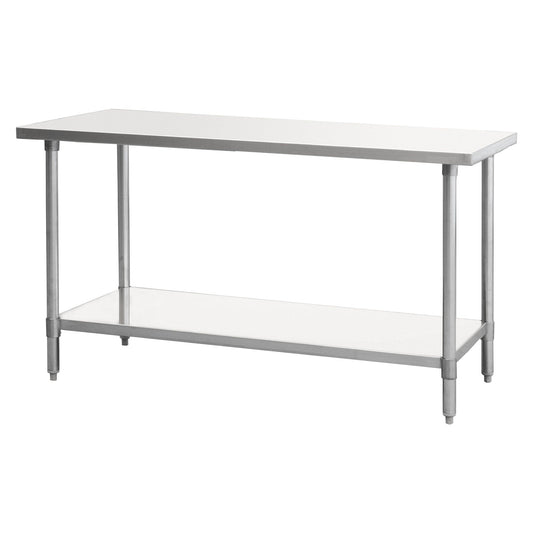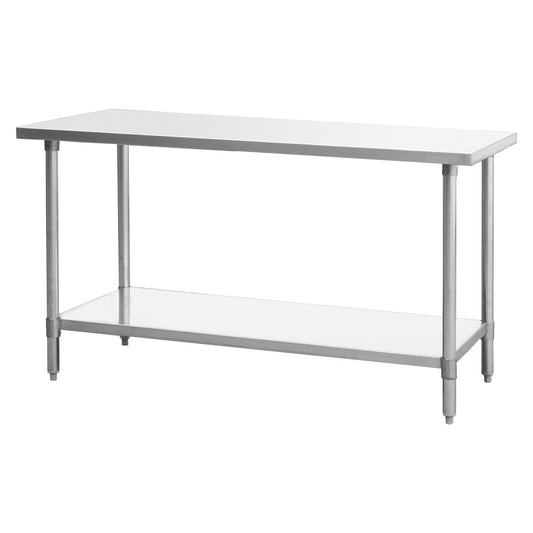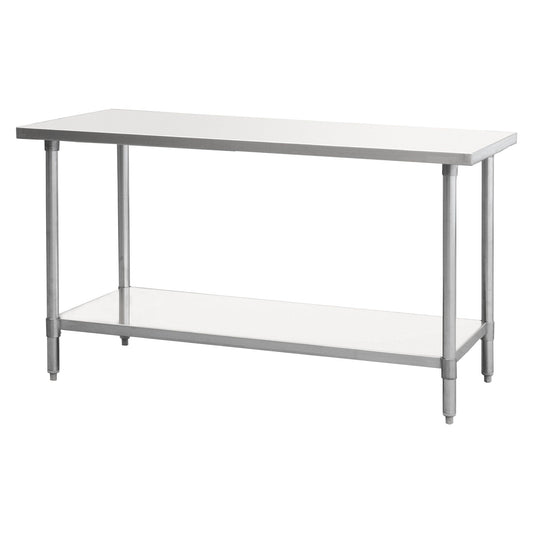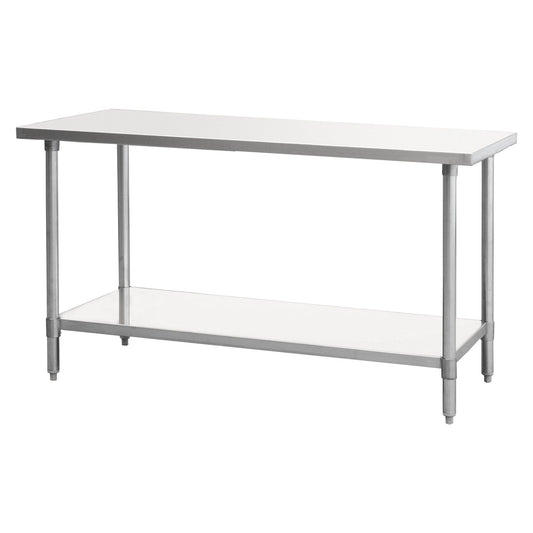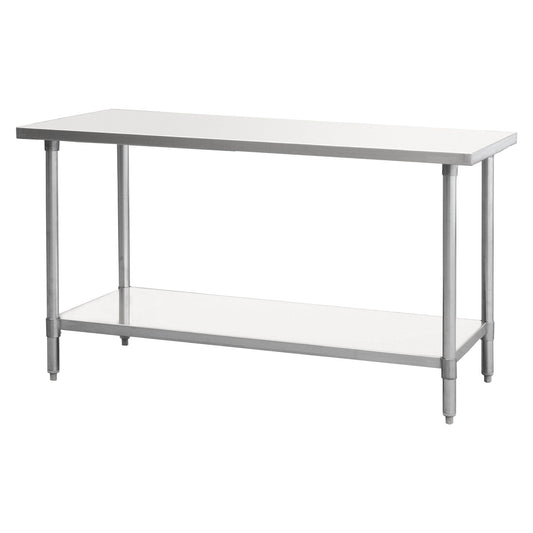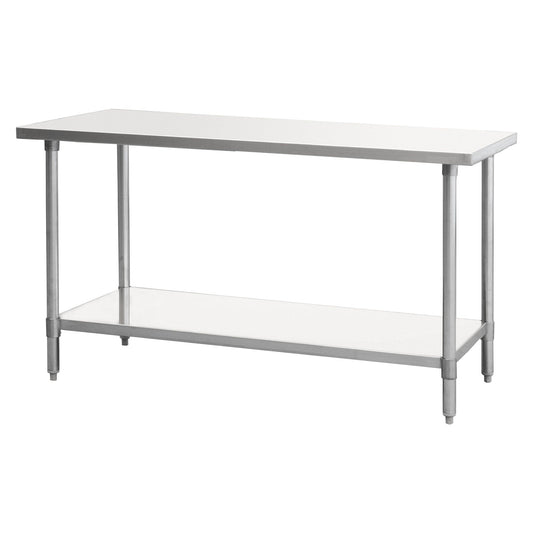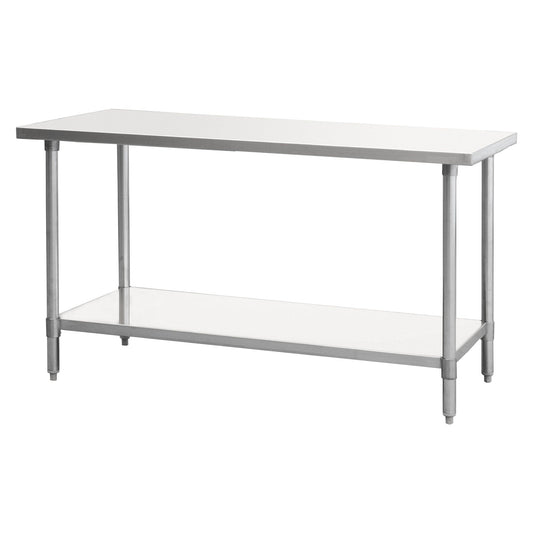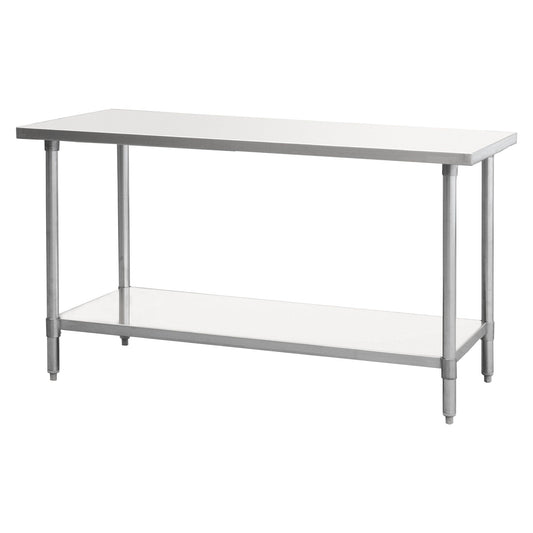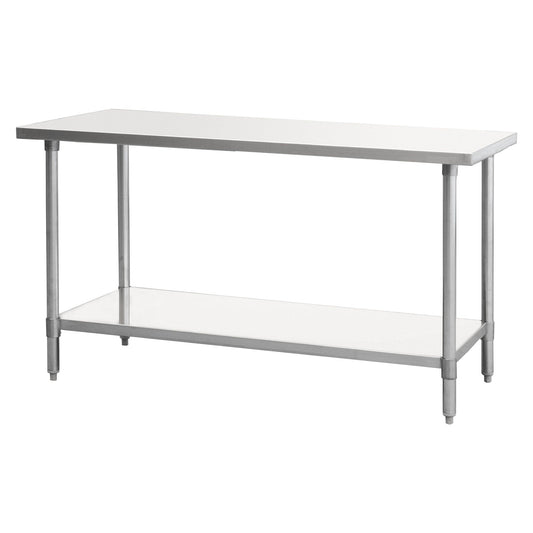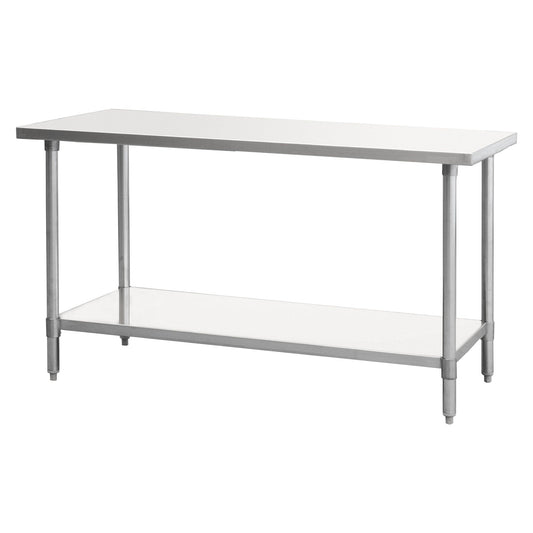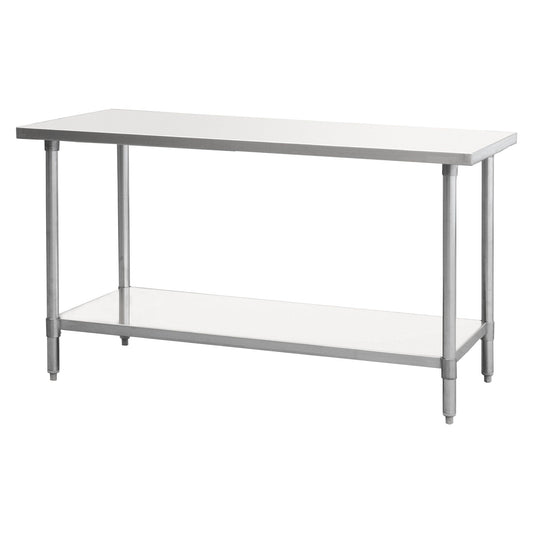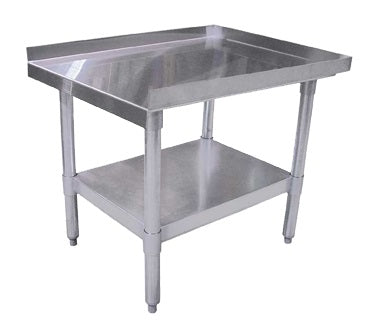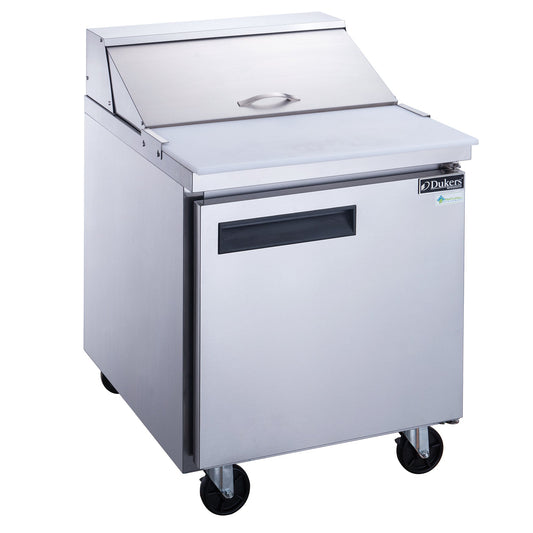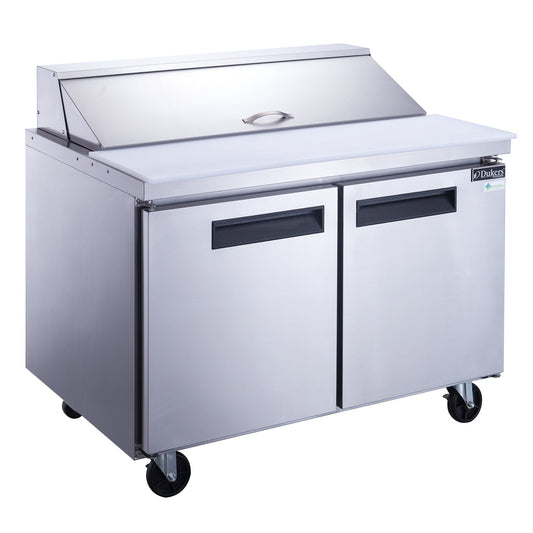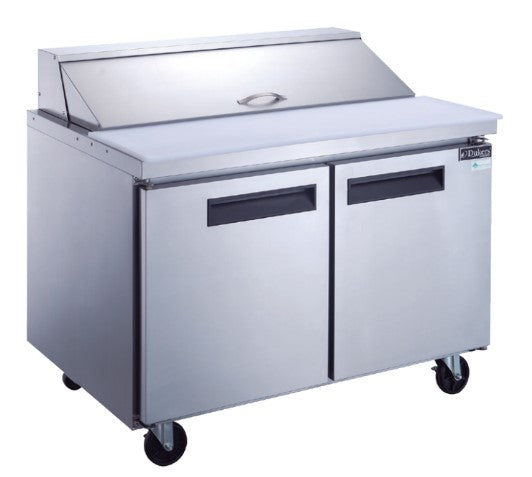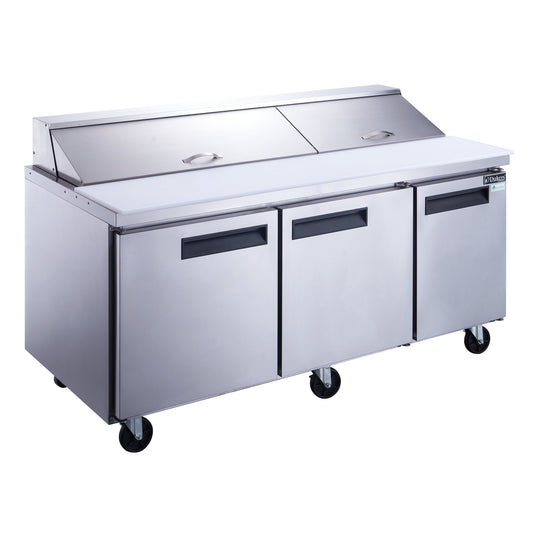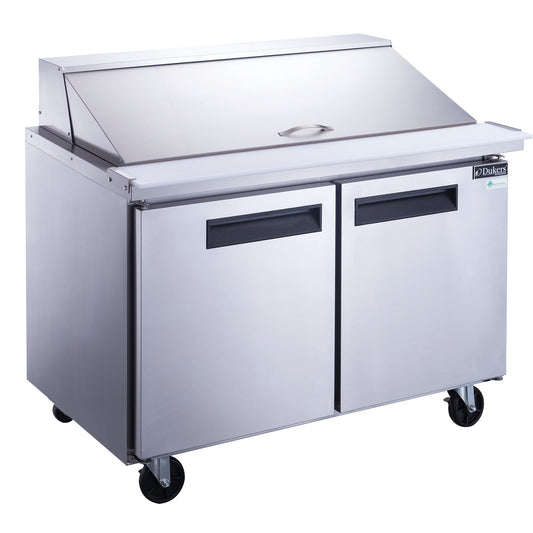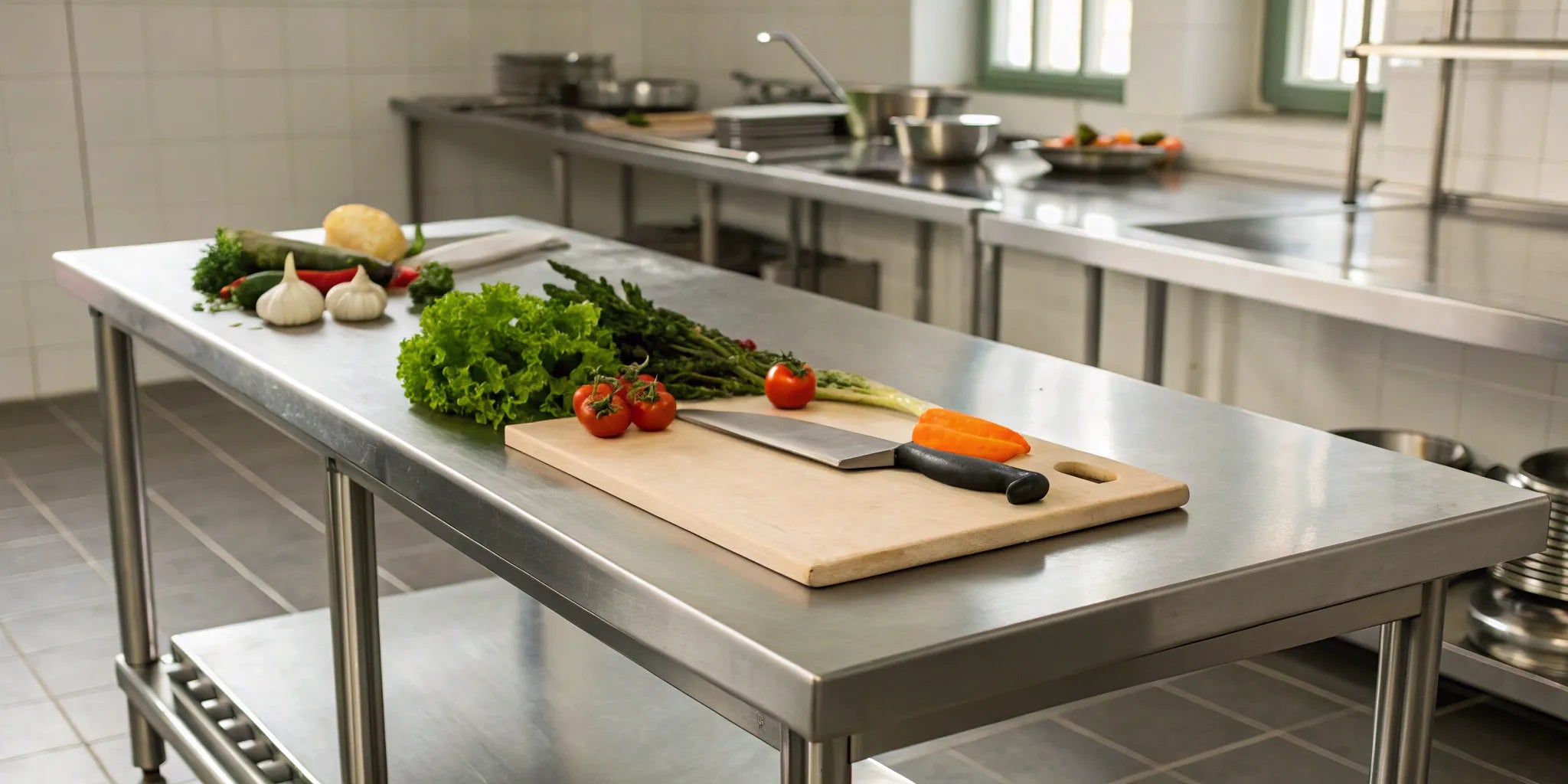
Prep Tables
Stainless steel prep tables are strong and easy-to-clean material. It resists corrosion and staining.
Stainless Steel Prep and Work Tables
Sean Kearney of The Restaurant Warehouse has purchased PrepTables.com and will continue to offer new pizza prep table equipment at used prices.
The Dukers stainless steel work table is a type of table used in commercial kitchens, labs, and industrial settings. They are made from stainless steel, which is strong and easy to clean. This material resists corrosion and stains. Stainless steel work tables often have an adjustable shelf underneath for storing equipment and supplies. They may also have a backsplash to protect walls from spills. These tables are a good option for food service places, labs, or any industrial setting. They provide a strong and easy-to-clean work surface.
-
24 Inches x 24 Inches Stainless Steel Prep Table
Regular price $282.00Regular price -
24 Inches x 30 Inches Stainless Steel Prep Table
Regular price $310.00Regular price -
24 Inches x 36 Inches Stainless Steel Prep Table
Regular price $355.00Regular price -
24 Inches x 48 Inches Stainless Steel Prep Table
Regular price $399.00Regular price -
24 Inches x 60 Inches Stainless Steel Prep Table
Regular price $440.00Regular price -
24 Inches x 72 Inches Stainless Steel Prep Table
Regular price $531.00Regular price -
30 Inches x 36 Inches Stainless Steel Prep Table
Regular price $392.00Regular price -
30 Inches x 48 Inches Stainless Steel Prep Table
Regular price $445.00Regular price -
30 Inches x 60 Inches Stainless Steel Prep Table
Regular price $531.00Regular price$0.00Sale price $531.00 -
30 Inches x 72 Inches Stainless Steel Prep Table
Regular price $594.00Regular price -
30 Inches x 96 Inches Stainless Steel Prep Table
Regular price $770.00Regular price -
Stainless Steel 24-inch Equipment Stand
Regular price $250.00Regular price$321.00Sale price $250.00Sale
Blog posts
View all-

Using Carbon Off Cleaner Like a Pro
Learn how to use carbon off cleaner safely on commercial kitchen equipment. Our guide covers prep, application, and common mistakes to avoid.
Using Carbon Off Cleaner Like a Pro
Learn how to use carbon off cleaner safely on commercial kitchen equipment. Our guide covers prep, application, and common mistakes to avoid.
-

How to Fix Your Ice Maker Water Leak Fast
Discover how to diagnose and fix an ice maker water leak yourself. Our guide offers clear, actionable steps for common issues, saving you time and money.
How to Fix Your Ice Maker Water Leak Fast
Discover how to diagnose and fix an ice maker water leak yourself. Our guide offers clear, actionable steps for common issues, saving you time and money.
-

Stainless Steel Grades Explained for Kitchens
Our complete guide to stainless steel grades explained. Learn the difference between 304 and 430 steel to choose the right equipment for your kitchen.
Stainless Steel Grades Explained for Kitchens
Our complete guide to stainless steel grades explained. Learn the difference between 304 and 430 steel to choose the right equipment for your kitchen.
Sandwich Prep Tables
The refrigerated sandwich prep tables are well-made to be small and save space. They are a great choice for any kitchen. Their unique design is specifically tailored for efficient sandwich and salad preparation, enhancing your culinary workflow.
-
Dukers DSP29-8-S1 29 inch Sandwich/Salad Prep Table
Regular price $1,781.00Regular price$2,543.80Sale price $1,781.00Sale -
Dukers DSP48-12-S2 48 inch Sandwich/Salad Prep Table
Regular price $2,544.00Regular price$3,634.00Sale price $2,544.00Sale -
Dukers DSP60-16-S2 60 inch Sandwich/Salad Prep Table
Regular price $2,946.00Regular price$4,209.00Sale price $2,946.00Sale -
Dukers DSP72-18-S3 Sandwich/Salad Prep Table
Regular price $3,373.00Regular price$4,818.50Sale price $3,373.00Sale -
Dukers DSP29-12M-S1 6.5 cu. ft. 29 inch Mega Top Sandwich Prep Table
Regular price $2,013.00Regular price$2,875.00Sale price $2,013.00Sale -
Dukers DSP48-18M-S2 11.4 cu. ft. 48 inch Mega Top Sandwich Prep Table
Regular price $2,896.00Regular price$4,137.70Sale price $2,896.00Sale -
Dukers DSP60-24M-S2 60 inch Mega Top Sandwich Prep Table
Regular price $3,234.00Regular price$4,620.70Sale price $3,234.00Sale -
Dukers DSP72-30M-S3 17.5 cu. ft. 72 inch Mega Top Sandwich Prep Table
Regular price $3,703.00Regular price$5,290.00Sale price $3,703.00Sale
Pizza Prep Tables
Discover the Dukers Pizza Prep Table - the ideal solution for storing and preparing ingredients in any commercial kitchen.
-
Dukers DPP44 9.8 cu.ft 44 inch Single Door Pizza Prep Table
Regular price $2,895.00Regular price$4,135.40Sale price $2,895.00Sale -
Dukers DPP70 17.5 70 inch 2-Door Pizza Prep Table
Regular price $4,080.00Regular price$5,828.20Sale price $4,080.00Sale -
Dukers DPP90 24.8 cu. ft. 3-Door 90 inch Pizza Prep Table
Regular price $5,144.00Regular price$7,348.50Sale price $5,144.00Sale
Work Tables
What is a Stainless Steel Preparation Table?
A stainless steel preparation table is a vital component of any commercial kitchen. It offers a sturdy and sanitary work surface suitable for various food preparation tasks, ranging from sandwich assembly to ingredient portioning. Typically constructed from high-grade stainless steel, this non-porous material effectively inhibits bacterial growth, which is crucial for maintaining food safety. These prep tables are available in multiple sizes to accommodate different kitchen designs and workflows. Additionally, many models feature convenient elements such as undershelves for storage, adjustable feet for enhanced stability, and backsplashes to control spills. This versatility makes them an indispensable addition to any restaurant, cafeteria, or food service establishment. An excellent prep table can greatly enhance your kitchen's productivity and help create a safer, more organized environment.
Essential Characteristics of Commercial Preparation Tables
Acquiring a stainless steel prep table is a wise decision for any eatery. However, selecting the appropriate one entails knowing essential characteristics. Here’s a breakdown of what to consider:
Dimensions and Size
Preparation tables are available in a range of dimensions, from compact 24" x 48" designs to larger 30" x 72" models. It's important to take into account your kitchen's layout and workflow. Is there sufficient counter space available? A smaller prep table may be ideal for a quaint cafe, whereas a busy restaurant will probably require a more extensive surface. Consider how much space you have and the number of individuals who will be using the table.
Measurement and Resilience
The term "gauge" in relation to stainless steel indicates its thickness; a lower gauge number signifies a thicker material. For instance, 16-gauge stainless steel is more robust, providing enhanced durability suitable for the rigorous needs of a bustling commercial kitchen. Our prep tables designed for longevity. It's essential to seek out commercial-grade stainless steel and verify NSF certification, as this ensures compliance with sanitation requirements. This is particularly crucial in a high-pressure setting where cleanliness is paramount.
Load Capacity
Think about what items you will be preparing on your table. If you're using heavier ingredients or equipment, it's essential to choose a table that has a higher weight capacity. Always refer to the manufacturer's specifications to confirm that the table meets your requirements. The cost of prep tables can vary significantly, with prices ranging from several hundred dollars to more than two thousand, typically reflecting variations in size, gauge, and features. Our prep tables, provides a solid foundation for your consideration.
Add-ons
Certain prep tables include useful features such as integrated cutting boards, drawers, or lower shelves. These elements can optimize your workflow and help maintain an orderly workspace. Consider which accessories would best suit your unique requirements. BK Resources, offers specialized tools, that can further improve your prep table arrangement.
Leading Brands of Prep Tables
Choosing the appropriate prep table involves more than just assessing its dimensions; it also requires evaluating the reputation of the brand. Below is an overview of several top brands recognized for their quality and longevity.
Evaluate Prices and Worth of Prep Tables
When it comes to buying a stainless steel prep table, maximizing your investment is essential. Familiarizing yourself with the price ranges, the elements that affect the cost, and methods to evaluate long-term value will enable you to make an informed decision. Let’s explore how to analyze prep table prices and guarantee that you acquire a reliable and practical addition to your kitchen.
Cost Categories
The cost of prep tables can vary greatly, ranging from several hundred dollars to more than two thousand. Entry-level models, which are generally smaller and come with limited features, begin at approximately $100. Larger tables that include additional features such as drawers or adjustable shelving typically come with a higher price tag. High-end, heavy-duty tables designed for substantial usage can exceed $2,000. Understanding this price range provides a useful baseline.
Elements Affecting Expense
The final cost of a stainless-steel prep table is influenced by multiple factors. One of the primary considerations is the gauge of the stainless steel; a lower gauge number signifies thicker and more resilient steel, which typically comes at a higher price. The size and dimensions of the table are important as well, with larger tables generally commanding higher costs. Additional features, such as integrated drawers, undershelves, or backsplashes, can further increase the total price. It’s essential to assess your requirements and financial plan to achieve the ideal compromise. For instance, BK Resources focuses on heavy-duty tables, which can affect their pricing. Similarly, our prep table webiste provides a range of sizes, which also impacts their prices.
Sustainable Worth
Consider the overall value rather than just the purchase price. A well-cared-for stainless steel prep table represents a worthwhile long-term investment. By focusing on high-quality materials and solid construction from the beginning, you can avoid future costs associated with repairs or replacements. Regular cleaning and consistent maintenance are crucial. Seek out features such as adjustable legs to accommodate uneven surfaces and robust construction to endure everyday use. Making a thoughtful investment and properly maintaining your prep table will enhance its longevity and value over time.
Select the Appropriate Preparation Table
Choosing the appropriate prep table is a significant choice for any eatery. As a vital piece of equipment, it's essential to ensure it meets your specific requirements. In this section, we will guide you through important factors to assist you in selecting the ideal option for your kitchen.
Evaluate Your Environment and Processes
Various commercial kitchens have distinct needs for restaurant equipment. For instance, the ideal prep table for a pizzeria may not suit an ice cream shop or a food truck. Prior to beginning your search, ensure you take precise measurements of the space you have. Keep in mind not just the dimensions of the table, but also the space required for doors and drawers to function properly. Additionally, consider how your staff navigates the kitchen during peak service periods. A sandwich prep table positioned incorrectly can disrupt the workflow and lead to congestion. Envision how the prep table will fit into your current layout and enhance the overall efficiency of your kitchen.
Tailor Features to Your Requirements
Prep tables are available in a wide range of designs. Some models are equipped with integrated cutting boards, while others provide storage space beneath the counter. Take into account the type of food preparation you will be undertaking. How much refrigerated space do you need? Consider the layout that best accommodates your ingredients and method of preparation. Will you require distinct compartments for various items? A separation between the upper bins and the refrigeration area below can be essential for certain operations. Different refrigeration systems present various levels of temperature regulation, so select one that meets your particular requirements.
Personalization Choices
Numerous prep tables come with customizable features to better fit your kitchen's needs. You can enhance storage with adjustable undershelves, while over shelves make it convenient to access items you use often. For kitchens with limited space or those that require flexibility, foldable designs are ideal. Additionally, casters provide mobility, enabling you to move the table with ease. Backsplashes not only shield your walls from spills but also help maintain a tidy appearance. Familiarizing yourself with the type of stainless steel used in your tables will assist in identifying the most effective cleaning and maintenance methods, ensuring durability and peak performance.
Keep Your Prep Table Clean and Maintained
Maintaining the cleanliness of your prep table goes beyond aesthetics; it plays a crucial role in ensuring food safety and prolonging the lifespan of your equipment. An effectively cared-for prep table enhances the efficiency and sanitation of your kitchen.
Daily Cleaning
Regular cleaning is crucial for the upkeep of prep tables. After every use, it's important to clean all surfaces using a microfiber cloth along with a gentle detergent solution. Microfiber is ideal for cleaning stainless steel without causing scratches. Always wipe in the direction of the grain on the stainless steel to avoid streaks and keep its shiny appearance intact. For more stubborn dirt, a stainless steel cleaner may be beneficial, but be sure that it is suitable for the material of your table.
Sanitization
Sanitization is more than just cleaning. Cleaning eliminates apparent dirt and food particles, whereas sanitizing effectively eradicates bacteria and other dangerous microorganisms. Once you have cleaned your prep table, make sure to sanitize it using a suitable sanitizing solution. Always adhere to the manufacturer's guidelines for the sanitizer you select to guarantee its effectiveness and prevent any potential harm to the stainless steel.
Avoid Rust and Damage
Stainless steel is known for its durability, yet it necessitates appropriate maintenance. Make it a habit to check your prep table regularly for any indications of rust, particularly in moist areas. It's essential to tackle rust spots quickly to stop them from spreading. Steer clear of harsh chemicals or abrasive cleaning agents, as they can harm the surface and heighten the risk of rust formation. Keep in mind that various materials require different cleaning techniques. For example, plastic components should be washed with warm, soapy water rather than stainless steel cleaners. By implementing these precautionary steps, you can prolong the lifespan of your prep table and maintain its excellent condition.
Health and Safety in the Prep Area
Preparation tables play a crucial role in any professional kitchen. However, their advantages are fully realized only when they foster a safe and hygienic workspace. Let’s explore how the appropriate prep table, along with effective practices, enhances the success of a kitchen.
NSF Certification
When selecting prep tables, prioritize those with NSF certification. This certification indicates that the table adheres to strict public health standards. Equipment bearing the NSF mark is more straightforward to clean and disinfect, which helps minimize the chances of foodborne illnesses. For example, Our stainless steel prep tables provides a variety of NSF-certified stainless steel prep tables, ensuring they comply with high-quality and durability standards. This certification assures you that your investment contributes to a safe and healthy kitchen environment.
Adherence to Food Safety Regulations
Keeping a tidy prep table is essential for adhering to food safety regulations. Consistent cleaning and sanitizing help remove dangerous bacteria and various microorganisms. It’s important to set up a daily cleaning schedule and adhere to the correct sanitization methods. Helpful resources, such as INSERT, provide valuable insights into effective cleaning practices. A spotless prep table is a key component in maintaining food safety standards and ensuring the safety of your customers.
Ergonomics in the Kitchen
A preparation table should not only be clean but also enhance a comfortable and efficient working environment. The concept of kitchen ergonomics is crucial for the well-being and productivity of the staff. It's essential to consider the height and depth of your prep table in relation to the average height of your employees. An inappropriate table height may result in back pain and other injuries.
In conclusion, a well-chosen prep table plays a crucial role in creating a healthy and efficient kitchen atmosphere. It not only enhances workflow but also promotes better food safety practices.
